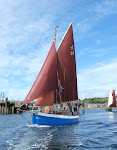Going to Port Saint Mary was a mistake. The bay is
exposed to the south, and almost as soon as we arrived the wind got
up from that direction and Robinetta started rolling horribly
in the swell. Even though we were tired we could not stay there.
Heading back round the Calf of Man to Peel would have seen us beating
which did not appeal.
Instead we decided to head for Douglas, and came off the mooring at
10:00, with no fog left to obscure the passage.
I laid in a course to take us clear of the overfalls
off Dreswick Point, and Julian stayed below to try and get more
sleep. I kept looking left, contemplating the two mile detour out to
sea. We were close to high water and I could not see any disturbed
water off the point, so I decided to cut across. This was not a good
idea.
We had had the tide with is through the overfalls
coming out of Strangford. This time we had it against us, with a
stronger wind behind us. Robinetta, lovely lady that she is,
just bobbed up and down and sideways, never feeling unsafe although
the steering was hard work. Worm bumped into Robinetta's
stern once, but generally hung far enough behind and somehow never
took a drop of water on board. Robinetta did get some splashes
into the cockpit, and I asked Julian to close the door, just in case
a bigger one came in!
Eventually we were through, although it took a while
at 1.8 knots! Immediately we were in smoother seas we were making 3.5
knots again. Going round the overfalls would have been quicker, and a
lot easier.
We headed up the coast to Douglas with following sea
and winds, but motor sailing all the way to make up for the tide
being against us. As I checked the course I had put in I noticed we
had just entered the Port of Douglas's Harbour Control area and
decided to give them a call to say where we were. I used the phone as
I was not sure they would be listening on VHF, but they told me to
use the VHF and give them a call again when we were 10 minutes from
the harbour, since Manannan, the fast cat ferry service from
Belfast, would be arriving in the harbour at about the same time as
us.
I went on listening watch on channel 12, and about 1½
hours later heard Douglas advising Manannan that
the small yacht they could see was probably Robinetta, and
that they would call us to check we would stay clear. It gave me a
good feeling that they could ID us due to my call, but I was less
pleased to be called on the VHF and be told that we needed to turn
away and wait south of the entrance.
Turning into the wind felt like quite a difficult
manoeuvre where we were, with the following wind and sea, but we complied and
it was much easier than expected. Being tired both Julian and I were
seeing problems where none existed. Mannanan soon cleared into
the harbour and we were free to follow.
The sailing Cruise Liner Wind Surf was
anchored in the bay, sending her tenders ashore to the secure landing
stage inside the harbour. They were rolling like anything, and
Robinetta did the same
as we lowered the main, so I did not make a neat job of it.
 |
| On the waiting pontoon |
I got the bowsprit
in, and tidied up the foredeck while Julian raised the main
sail and and took the reef
out since he wanted to tighten the outhaul on the boom. One of the
gaff robands had snapped, so he replaced it, and retied the gaff
outhaul to tension the top of the sail properly too. He then went on
to glue and restrap the tiller
pilot attachment point on the tiller. Both of us were pretty much
operating on autopilot ourselves. It was 14:30 when we reached
Douglas but Julian had to work through his adrenalin rush
before he could relax.
The marina staff
visited us on the waiting pontoon and gave us a plan of the marina,
with the berth Robinetta
should take marked on it. They
also gave really useful
advice about when to call Douglas Harbour and ask for the bridge to
be lifted so we could get into the marina. There is a flap gate,
which hold the water inside the marina, and entry is only possible
for two hours either side of high water. The
road bridge crosses the
harbour just above the flap gate, and needs
to lift to allow entry.
Once Robinetta's
mainsail cover was on we had a light lunch, then got the bed out and
slept for a couple of hours. We wanted to move Robinetta
as soon as possible, but this
was not until 2045 when the flap gate would open, so we took the
chance for a much needed rest.
After a couple of
hours in bed we went for a walk to check out our new berth, and on
the way back Julian saw the lifeboat launch down its slipway.
Despite
the force 6 winds there were 4 yachts racing
in the bay. Once of them ended up beached, and the lifeboat launched
to recover it and tow it back into harbour. We could see most of the
events from Robinetta,
and had a ringside seat to see the lifeboat being winched back up the
ramp and into its shed.
In contrast moving
into the marina was totally non traumatic, even
though the wind blew us off our assigned berth and we had to go round
again, and we were safely
moored
up inside by 2100.


































